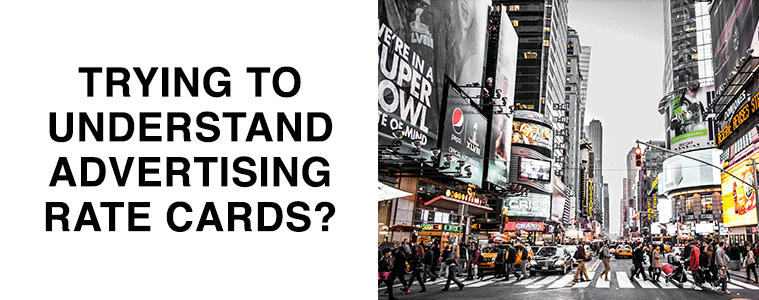
Understanding advertising rates for your small business can seem like a daunting task. From ad size to location to mechanical specifications and deadlines, there are a number of factors that will influence the cost of a particular advertising method or channel. However, sorting through the options on rate cards doesn't need to be difficult. We'll help you decipher a typical rate card by breaking down what the most common sections really mean and how they may influence your advertising decisions.
At Profitworks, we are a team of marketing experts with one objective: making you the market leader in your industry. Wondering how you can partner with our team to improve your advertising results? Contact us today.

Before diving into the minutiae of advertising rate cards, let's start by unpacking what they are.
Advertising Rates: What are Cards Used For?
An advertising rate card is a document or template used by advertisers to determine how much it will cost to run an advertisement, based on a series of qualifiers. Often referred to as "cheat sheets," rate cards are most frequently used by newspaper and print publication companies to efficiently charge for space in their media.
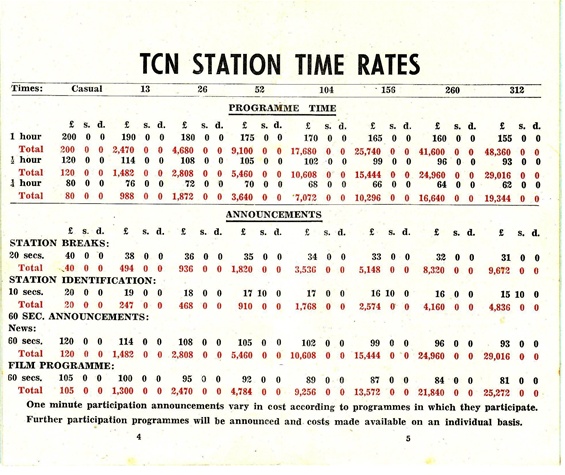 One of the first advertising rate card's for an Australian broadcasting business in the 1950's.
One of the first advertising rate card's for an Australian broadcasting business in the 1950's.
Based on the size of the company providing the rate card, the information listed will vary. For example, a small-scale community newspaper may have fewer placement or run-time options on their rate card than an international newspaper with weekly distribution and thousands of readers would.
Now that we have a better understanding of what advertising rate cards are, let's dive into some of the factors that will influence the advertising rates listed.
Ad Size and Dimensions
One of the most well-known indicators of an advertisement's cost is how much visual space the ad will take up, whether that space is in a print publication or on a company website. Advertising cards will typically offer a number of rates for sections on their pages, with print publications offering options for full, 1/2, 1/3, and 1/4 page ads, among other options such as "marketplace" sections with multiple advertisements. Quite simply, the larger the ad space, the more costly the advertisement will be.
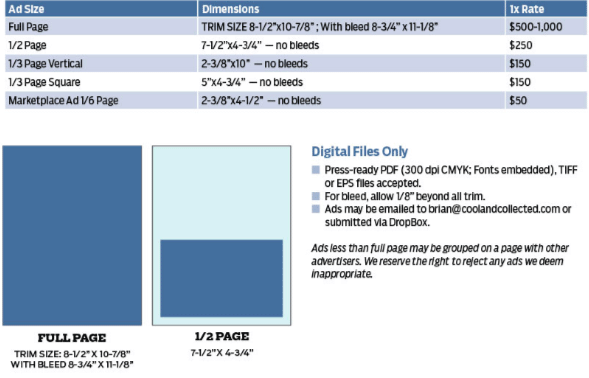 Advertising rates will increase depending on the size of the advertisement you choose to submit.
Advertising rates will increase depending on the size of the advertisement you choose to submit.
As seen in the example above, a full page in this print publication can cost up to 1900% more than a marketplace advertisement (taking up only 1/6 of the page in a print publication). Given that readers glance over pages quickly, a full page has a much greater impact in communicating a marketing message than 1/6 of a page. However, purchasing the largest advertising space will not always be the best decision for your marketing dollars. While it may have a greater short-term impact, publishing 1/6 page marketplace ads throughout the entire year may yield better long-term results.
Ad Placement
Similar to ad size and dimensions, ad placement will also significantly increase or decrease the advertising rates for a company. While many publications and websites will offer a number of placement options, the most sought-after advertising spots are the front cover, the back cover, and the front and back cover insides. These spots are often charged at a "premium" given their demand—and companies will often emphasize their exclusivity by encouraging and incentivizing early bookings.
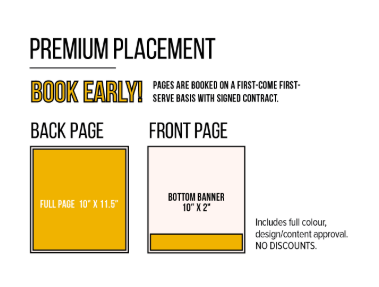 "Premium" placements, like the back or front of an ad, are often first to sell given their exclusivity.
"Premium" placements, like the back or front of an ad, are often first to sell given their exclusivity.
The placement of your ad, whether print or digital, also depends on your advertising objectives. If you are running a short-term campaign with the goal of boosting seasonal sales, investing in front-page placement will likely help you achieve your goal. However, for a retail store trying to increase the number of visits over time, spending less on advertising placement will create space in the budget for longer-term initiatives. Consider your advertising timeline when determining what type of ad placement is right for you.
Frequency
Frequency is often one of the most difficult areas to evaluate when considering advertising rate cards. You may be wondering what level of frequency will lead to the highest return for your business, and consequently, how much to invest in each individual advertisement in terms of dimensions, placement, messaging used, and more. There's not always a right or wrong answer to the question of how frequently or infrequently you should advertise. Instead, your decision should depend heavily on the nature of your objectives, the nature of your product or service, and overall market trends.
As previously mentioned, the internal goals of your campaign will influence the dollars you spend throughout the campaign timeline, but there are external factors to consider as well. First, the nature of your product or service will impact how frequently you should advertise for the highest return on investment. A Christmas tree manufacturer, for example, should not spend its budget on annual advertisements throughout the newspaper but should instead invest heavily in open advertisements in October, November, and December, the months in which the most people are looking to buy.
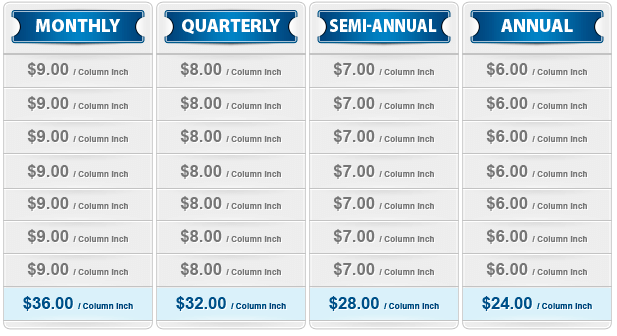 Committing to annual advertisements will result in a lower cost-per-ad than publishing monthly or weekly.
Committing to annual advertisements will result in a lower cost-per-ad than publishing monthly or weekly.
Market trends will also have an external influence on the frequency of advertising. For example, Cadbury Mini Eggs used to be a candy that was only available leading up to and immediately following Easter. However, when consumers demanded that the candy be available year-round, Cadbury shifted their strategy to allow for some advertising throughout the year with a major increase surrounding Easter when sales tend to peak.
As you can see, it's important to analyze advertising rates carefully when it comes to frequency. Use your advertising rate card to strategize and get the highest return on your advertising dollars possible.
Coverage Area and Demographics
Depending on where you are publishing your ad you may be met with options or limitations in terms of coverage area and demographics for that particular coverage area. For example, a newspaper is typically circulated in a specific location and has a certain "readership" (a group of people that actually reads the papers that are circulated) that does not often change. On the other hand, an online advertisement might allow for a greater range in terms of audience demographics and other options in terms of targeting your ad.

Although it is impossible to guarantee whether the demographic listed on an advertising rate card will actually read or view your content (although reputable publications will have stronger readership rates), the information presented is still important to consider. After looking at the rate card, does your target audience actually line up with that of the company you're advertising through? Is their circulation to readership rate low? If there are discrepancies between the demographic information listed and the objectives you've outlined for your campaign, the channel may not be right for you.
Impressions
Impressions, sometimes referred to as "views", are the number of times someone views your advertisement. Impressions are an obvious objective of every marketing campaign. You want to ensure that your advertisement is being seen, so many advertising rate cards will include thresholds in which they can "guarantee" a certain number of impressions for dollars spent.
Quite simply, the more ads you publish and the larger they are (both in print or online), the more opportunity there is for the advertisement to be viewed by your target.
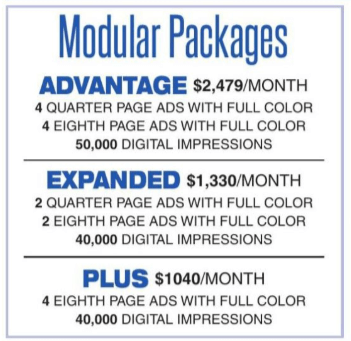
On advertising rate cards, impressions are often priced based on CPM - cost per thousand impressions. When choosing whether or not to splurge for the extra views, also consider your campaign objectives—an impression does not necessarily mean that the user clicked or purchased your product, so this metric may not be meaningful in helping you achieve your desired end result.
Deadlines
On any advertising rate card, the deadline section is self-explanatory—this section outlines the dates by which your content needs to be submitted for review in order to be published. Given the deadlines that publications themselves face, it is imperative that you meet the advertising deadlines outlined on the rate card.
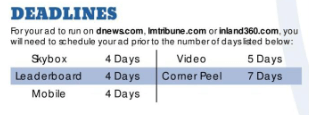
Oftentimes, companies will incentivize early submission by offering slight discounts on advertisements that are sent prior to deadlines. If you are able to coordinate an early submission with your team, it's an easy way to cut advertising costs for the same end result.
Contact Profitworks for Advertising Support
Now that you understand what some of the core sections of advertising rate cards really mean, you may be wondering what your next step is. Our team at Profitworks is here to help! Through our customized strategic marketing service, we can support your business in all aspects of the marketing process, from helping you design your campaign to setting objectives and reviewing the results. We'll help you find the right advertising rates for your business so that you can focus on what you do best.
Ready to get started? Contact us today!

"Our overall sales to new customers has improved as a result of detailed analysis, proposed solutions and successful execution.”
- Tom (Business Owner & Customer)
Read More Testimonials!
